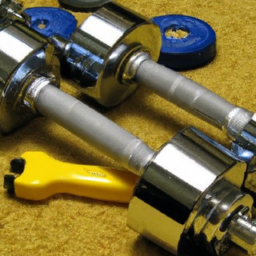Setting up a home multi-gym can be quite a task, especially if you’re new to fitness equipment. But don’t worry, we’ve got you covered! In this article, we will explore the average setup time for a home multi-gym and provide you with some tips and tricks to make the process easier. So, if you’re interested in getting your own home gym set up but are unsure of how long it might take, keep reading!
Curious to know more? In the upcoming paragraphs, you’ll discover the factors that influence setup time, such as the complexity of the multi-gym and your familiarity with the equipment. We’ll also share some useful tips on how to streamline the setup process and save you some precious time. Whether you’re a seasoned gym-goer looking to bring the workout experience home or a beginner just starting your fitness journey, understanding the setup time for a home multi-gym is essential. So, let’s dive in and make your home gym dreams a reality! Setting up a home multi-gym can be an exciting venture, but it is essential to consider the time and effort required for the assembly process. Several factors can affect the setup time for a home multi-gym, including the type and complexity of the multi-gym, an individual’s experience and familiarity, the availability of instructions and resources, the tools and equipment required, the space and accessibility of the area, the presence of additional features, the number of components and assemblies, the quality and fit of parts, the presence of preassembled sections, and personal pace and efficiency. In this article, we will explore each of these factors in detail to help you understand the average setup time for a home multi-gym.
Type and Complexity of the Multi-gym
The type and complexity of the multi-gym play a significant role in determining the setup time. Different types of home multi-gyms vary in design and structure, and the number of joints, moving parts, and connections can significantly affect the assembly complexity. Additionally, some multi-gyms may require the use of special attachments or add-ons, adding to the overall setup time. Before purchasing a home multi-gym, it is crucial to consider the type and complexity of the equipment to estimate the time required for setup.
Individual’s Experience and Familiarity
The experience and familiarity of the individual assembling the home multi-gym can impact the setup time. Previous setup experience can provide an advantage in understanding assembly procedures and interpreting assembly instructions. Individuals with prior knowledge of common pitfalls and challenges may be able to overcome obstacles efficiently, reducing the setup time. Moreover, skill in handling tools and fasteners also contribute to the overall efficiency of the assembly process.
Availability of Instructions and Resources
The availability of clear and detailed instruction manuals greatly influences the setup time for a home multi-gym. A well-written manual can provide step-by-step instructions, making the assembly process more manageable. In addition to printed instructions, the availability of online tutorials or videos can be helpful in visualizing the assembly steps. Access to customer support or help lines can also speed up the setup process by providing assistance when needed. Furthermore, the availability and accuracy of spare parts can save time in case of replacements or corrections.
Tools and Equipment Required
The tools and equipment required for assembling a home multi-gym can impact the setup time as well. Commonly needed tools, such as screwdrivers and wrenches, must be readily available. Depending on the multi-gym’s design, specialized equipment may also be required. It is important to have the appropriate tools and ensure their quality to avoid any potential delays or difficulties during the setup process.
Space and Accessibility
The availability of adequate space and accessibility in the area where the home multi-gym will be assembled is crucial for efficient setup. Sufficient room for maneuvering and assembly is necessary to ensure a smooth process. Additionally, clearance for the movement of parts and accessibility for tightening and fastening are essential factors to consider. Existing furniture or other obstacles can hinder the assembly process, so it is important to plan accordingly to avoid any delays or complications.
Presence of Additional Features
The presence of additional features in a home multi-gym can increase the setup time. Installation of extra attachments or modules, incorporation of adjustable settings, and assembly of integrated electronics or monitors can add complexity to the overall assembly process. Considering the time required for these additional features is important when estimating the average setup time for a home multi-gym.
Number of Components and Assemblies
The number of components and assemblies in a home multi-gym also affects the setup time. Counting the individual parts and sub-assemblies is essential to understand the scope of the task. Proper organization and grouping of components can make the assembly process more efficient. Furthermore, the presence of many small parts or large assemblies can significantly impact the overall assembly time. Understanding the interdependencies of different component categories is crucial for a smooth and timely setup.
Quality and Fit of Parts
The quality and fit of the parts provided with a home multi-gym can influence the setup time as well. Accuracy in manufacturing and machining is vital to ensure the components fit correctly. Tolerances and fit between components should be within acceptable ranges to avoid the need for adjustments or corrections during assembly. Defective or misaligned parts can cause delays and may require additional time to rectify.
Presence of Preassembled Sections
Some home multi-gyms come with preassembled sections, which can greatly reduce the overall assembly time. When considering the average setup time for a home multi-gym, it is important to take into account whether any preassembled sections are included. These sections can save time and simplify the assembly process, making it more efficient.
Personal Pace and Efficiency
Lastly, an individual’s personal pace and efficiency also contribute to the overall setup time. Factors such as familiarity with the equipment, experience in assembly, and confidence in handling tools can impact the speed at which the assembly process is completed. Personal motivation and focus also play a role in how efficiently the setup is done.
In conclusion, the average setup time for a home multi-gym depends on various factors. The type and complexity of the multi-gym, an individual’s experience and familiarity, the availability of instructions and resources, the tools and equipment required, the space and accessibility of the area, the presence of additional features, the number of components and assemblies, the quality and fit of parts, the presence of preassembled sections, and personal pace and efficiency all influence the setup time. By considering these factors, individuals can optimize their setup time for better efficiency and enjoy their home multi-gym in no time.

